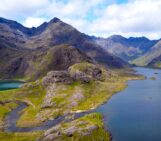
Geology has shaped the rugged landscape of the Isle of Skye – the largest island of Scotland’s Inner Hebrides archipelago. From the very old Precambrian rocks (approximately 2.8 billion years old) in the south of the island, through to the mighty glaciers which covered much of Scotland as recently as 14,700 years ago, the modestly-sized island provides a snap-shot through Earth’s dynamic history.
A far cry from its modern cold, foggy and drizzly weather, back in the Jurassic age (250 million years ago, or so), the island was part of hot and dry desert. Over time, the sea encroached the low-lying plain, depositing sands and muds, and later sandstones, as well as thin limestones and shales across the island. The best examples of these rocks are found on the western side of the island, on the Strathaird Peninsula, but they can also be found on northern and eastern coastal stretches too.
Fast-forward to the Tertiary period (approximately 60 million years ago) and the landscape changed dramatically. The calm tropical waters had made way for explosive eruptions, which vented lavas from crack’s in the Earth’s crust. The lavas blanketed large areas of the north of the island, covering the sediments deposited back in the Jurassic.
Long after the surface explosive activity ended, the cracks in the Earth’s crust continued to serves as pathways for molten magma to move below the surface. In the norther part of the island, the lava travelled sideways, pushing its way between the layers of Jurassic sedimentary rocks. The black lavas, layered between the lighter coloured limestones and sandstones (as pictured above), are in stark contrast with the present-day moss-covered cliffs.
The most spectacular examples of this layering of volcanic units atop sedimentary rocks can be seen not far from where this photograph was taken, at Kilt Rocks, in south Staffin. Visitors to the area can also enjoy Mealt waterfall, where water from Mealt Loch (the Scottish word for lake) tumbles spectacularly into the Sound of Raasay.
Marius Ulm, who captured today’s featured image, is a civil/coastal engineer meaning a totally different aspect of the geology captured his attention:
“From a coastal engineering point of view, what is interesting is the missing moss-cover at the cliff’s toe. There is a line which marks the transition where the rocks stop being covered by moss also indicates how high water regularly rises due to tides. It tells us the tidal range (difference between low and high water) reaches up to 5 m in this area.”
Imaggeo is the EGU’s online open access geosciences image repository. All geoscientists (and others) can submit their photographs and videos to this repository and, since it is open access, these images can be used for free by scientists for their presentations or publications, by educators and the general public, and some images can even be used freely for commercial purposes. Photographers also retain full rights of use, as Imaggeo images are licensed and distributed by the EGU under a Creative Commons licence. Submit your photos at http://imaggeo.egu.eu/upload/.

